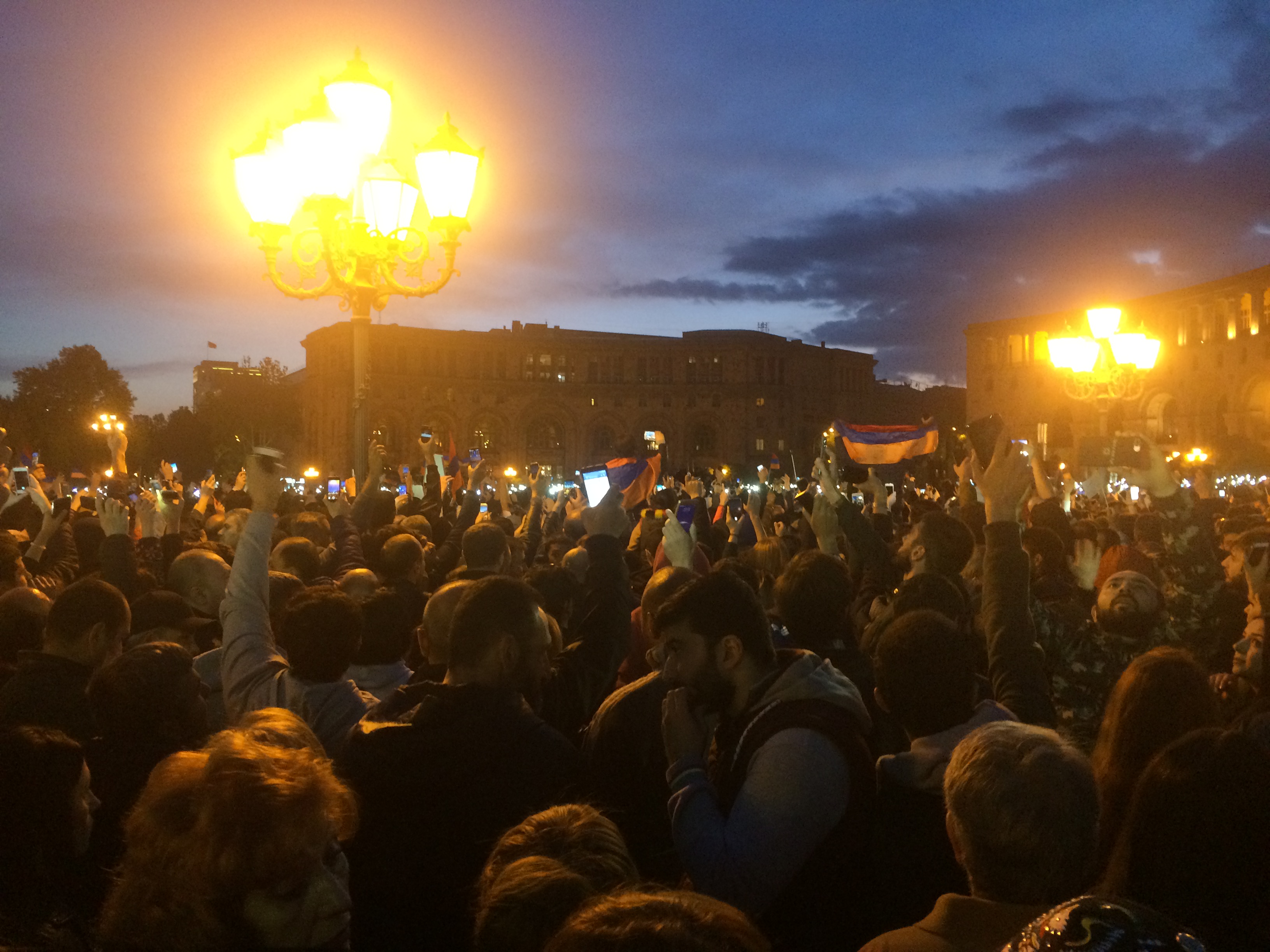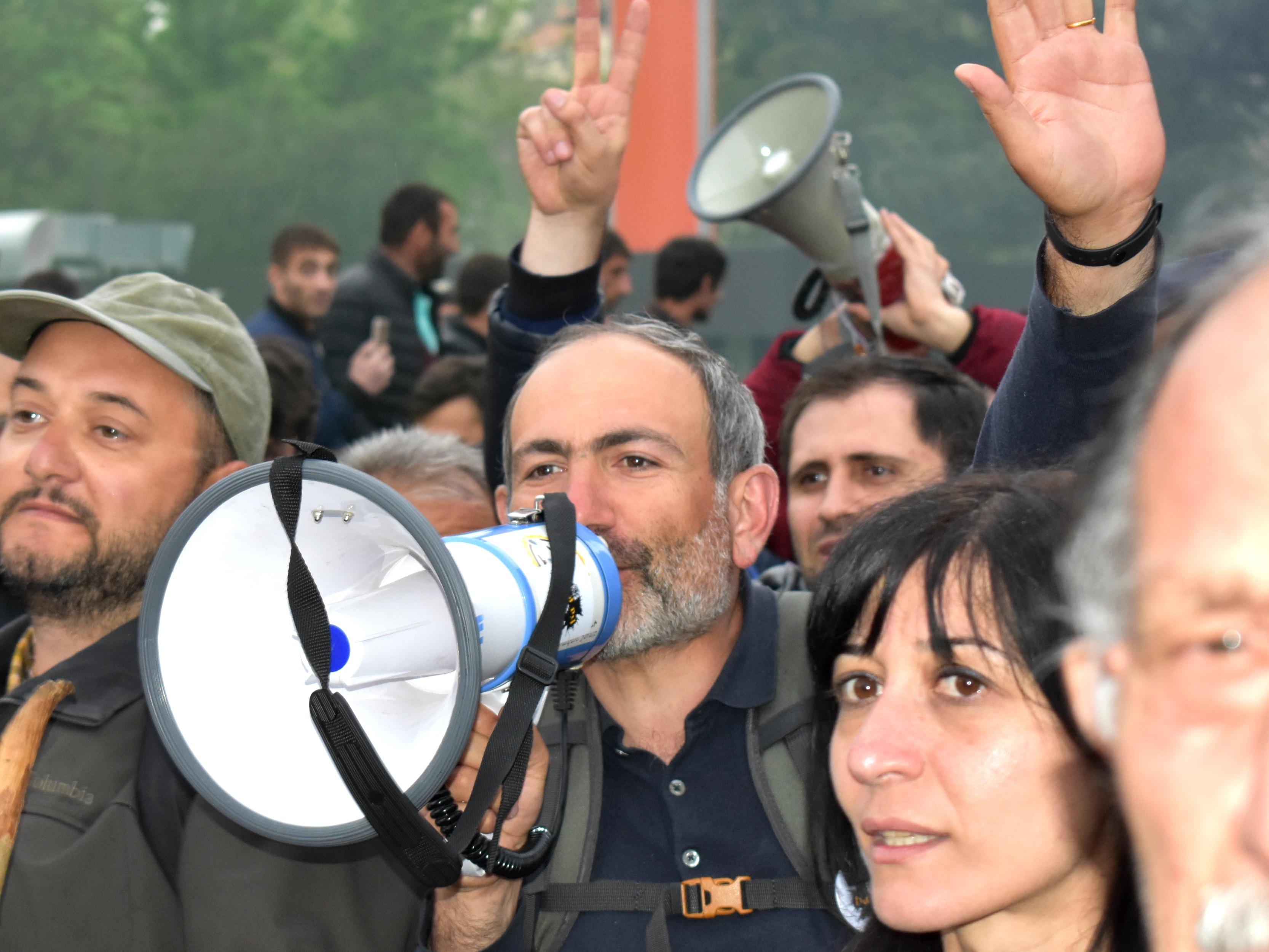To say that recent events in Armenia have caught observers – including yours truly - by surprise would an understatement. Its hybrid, semi-authoritarian regime, while highly unpopular, appeared relatively well-entrenched: all major challenges to its hold on power – usually following one of the country’s perennially flawed elections – had been successfully seen off in recent decades. The population had seemingly been cowed into apathy through a deft combination of repression (with the killing of opposition demonstrators in March 2008 as a particular low point), electoral bribes, administrative resources, ‘political technologies’, and the ever-present safety valve of emigration, to which the country had lost hundreds of thousands of its best and brightest – and possibly most rebellious – since independence.
The ongoing ‘velvet revolution’, as its protagonists call it, has put most of these certainties in doubt: a new generation of activists, most of whom are too young to remember the collapse of the Soviet Union, has taken over the streets of Armenia’s capital, Yerevan. The trigger was an attempted sleight of hand typical of the post-Soviet regimes that perennially hover between fully-fledged authoritarianism and pretend democracy: the ruling Republican Party had ensured a transition from a presidential to a parliamentary constitution in recent years, only to hand the now powerful Prime Ministership to the former President, Serzh Sargsyan, in a bid to allow him to maintain power beyond his two-term, ten-year limit, turning what appeared to be a welcome piece of democratic reform into a legislative hoax.
 |
| Demonstrators on Republic Square, Yerevan, Armenia, 22 April 2018 (Credit: Narek75) |
There was little indication, at first, that this move would meet with much resistance: the regime had been able to push through a stage-managed victory during the previous parliamentary elections in 2017, and the traditional opposition protests that followed – as after almost every one of the country’s post-independence polls - were a relatively timid affair. A new president – Armen Sargsyan (no relation) – had been elected and sworn in by parliament a few weeks ago. Having left the presidency for the position of Prime Minister – the new centre of power following the constitutional reforms – Serzh Sargsyan didn’t even have to change residences: overnight, Armenia’s presidential palace became the prime minister’s residence. For Armenia’s population, the message was one of inevitable continuity, tinged with a sense of mockery: all change, but no change.
But real change was exactly what the Armenian population has been craving for a long time: in decades of rule by an oligarchy that combined the country’s political, business and criminal elites in ways seen throughout the former Soviet Union, the grievances had never ceased to accumulate. Discontent at pervasive corruption; frustration at a small, stagnant economy marked by informal cartels and monopolies, often owned or protected by those in positions of political power; disgust at a culture of impunity putting a small group of oligarchs and their offspring above and beyond the law; impatience at the nepotism which made a travesty of meritocracy and excluded the brightest from the careers they deserved. And, above all, an end to the practice whereby subsequent governments kept up the pretence of democracy by making its usurpations of the same sufficiently ‘plausibly deniable’ to maintain a sheen of respectability towards the outside world.
The outburst of pent-up frustration came from the most unexpected quarter: the leader of the protests – Nikol Pashinyan – is the head of a radical opposition party, Yelk, which in the previous, admittedly flawed elections, garnered only 8% of the vote, and had therefore been seen as, at most, an annoying but manageable irritant by the regime. ‘Nikol’, as he is now colloquially known, nevertheless succeeded in galvinising a broad demographic that had, for a long time, been seen as too politically apathetic to count in the unaccountable comings and goings of Armenian politics.
 |
| Nikol Pashinyan (Credit: Yerevantsi) |
A veteran of anti-government protests – he was present during the bloody crackdown of 2008 – he and a close circle of activists had honed their skills in mobilising and utilising public discontent effectively. Thus, rather than the traditional static, centralised demonstrations, the ‘velvet revolution’ included flexible, mobile acts of peaceful civil disobedience powered by social media: a peaceful form of the hit and run guerrilla tactics that left Armenia’s police force at times comically unable to respond.
When, on Sunday 22 April, Serzh Sargsyan miscalculated by arresting Nikol, the result was a further galvanising of the protestors, and greater mobilisation. The fact that Armenia’s commemoration of the 1915 Genocide – on 24 April - was only hours away severely limited his options as well: no Armenian leader would want to be known as the man who ordered a violent crackdown against tens of thousands of peaceful protestors just before or on that particular day.
With the resignation of Serzh Sargsyan, Armenia’s revolutionaries have won one battle – but will they win the war? Attention has now switched to ending the rule of Armenia’s ‘Party of Power’, the Republican Party or HHK; but this will require longer-term vision and determination than what was required for the removal of one single man from within what remains a deeply corrupted system. Even the increasingly likely appointment of Pashinyan as the ‘people’s Prime Minister’, with a view towards organising free and fair elections, wouldn’t be sufficient in that regard.
In fact, Armenia is faced with two important questions if its revolution is to survive beyond this moment.
 |
| (Credit: Alexanyan) |
Firstly, the careful denial of the revolutions’ geopolitical aspect may become less tenable as time goes by. Armenia’s revolutionary leaders have always been keen to stress that the demonstrations are not aimed against Armenia’s strategic ally, Russia, and have, sensibly, avoided presenting Armenia as an example for other post-Soviet states to follow. But would Russia accept an Armenian state based on public accountability and liberal democracy - if only it submitted to its geopolitical priorities? Armenia is a test case for the Russian oligarchy’s ability to deal with a former Soviet republic not ruled through the unaccountable methods it is itself used to: as developments in recent days have shown, whether or not geopolitical orientation and regime type are two separate issues in Moscow’s eyes is still very much an open question.
Secondly, the oligarchy is larger than the HHK alone: Ukraine’s post-Maidan corruption woes provide a cautionary tale regarding the resilience of the post-Soviet political-business-criminal complex. To eliminate such an entrenched, all-pervasive system whose tentacles reach into every nook and cranny of Armenian society will take much determination: removing individuals from its informal structures – only to seem them replaced by other individuals – will not suffice. Some oligarchs – especially those who previously engaged in murder and violence – will have to be taken to account by a state reasserting its authority; the corrupt structures will themselves have to be dismantled. The question is how, and whether that will be accomplished – and, again, whether Russia will have the foresight to temper its imperial reflexes when it comes to Armenia’s internal politics, as and when these post-Soviet legacies are dealt with.
In that sense, winning what comes after the revolution will be as important as winning the revolution itself; and this cannot be done without a clear, positive, explicit, consensual programme that goes beyond the requirements of regime change, and manages the population’s currently sky-high expectations. This is where the revolution will succeed or fail; the challenge should not be underestimated.
No comments:
Post a Comment